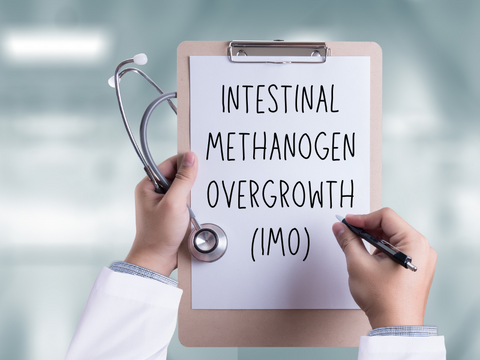
When it comes to gastrointestinal health, there are various conditions that can disrupt the delicate balance of our gut microbiome. In fact, it is estimated that 60-70 million Americans suffer from digestive disease in some form, with even more Americans experiencing symptoms without a formal diagnosis. Small Intestinal Bacterial Overgrowth (SIBO) and Intestinal Methanogen Overgrowth (IMO) are two such conditions that can cause distressing symptoms and impact overall well-being. While they may share similarities, it is important to recognize their differences in order to pursue appropriate diagnosis and treatment. Here we aim to shed light on the characteristics of IMO (pronounced “ee-moh”), how it differs from SIBO, methods of diagnosis, treatment options, and the role of the Low Fermentation Eating Diet in maintaining microbiome balance.
What is IMO?
The term “Intestinal Methanogen Overgrowth” was coined by our own, Dr. Mark Pimentel, as an alternative description for methane-dominant SIBO. IMO refers to an excessive presence of methanogenic archaea in the intestine. Unlike bacteria, archaea are single-celled microorganisms with distinct genetic characteristics, classifying them as a completely separate domain of life. Similar to bacteria, they are found naturally in the environment and can also inhabit the human gut – along with 100 trillion other types of bacteria! Methanogens are a type of archaea that produce methane gas during the breakdown of organic matter. Unlike SIBO, which is isolated to the small intestine, patients with IMO have an overgrowth of methanogenic archaea that can disrupt the microbiome balance of both the small and large intestines.
SIBO vs IMO
SIBO and IMO are closely related in most respects, but symptoms and treatment protocols can differ. Common symptoms of both SIBO and IMO include: abdominal bloating and discomfort, gas, alternating bowel habits, abdominal distention, histamine intolerance, nausea, loss of appetite, fatigue and weakness, amongst others. However, IMO is often associated with a higher prevalence of constipation due to the methane-producing capabilities of methanogenic archaea.

Root Causes of IMO
While there are many possible root causes of both SIBO and IMO, certain factors may increase the risk. Individuals with a history of intestinal surgeries, lower motility, or those with certain gastrointestinal disorders may be more susceptible to developing either SIBO or IMO. When determining the root cause of your gastrointestinal disorder, it’s important to understand the difference between modifiable and non-modifiable root causes. Modifiable causes of SIBO or IMO have the ability to be addressed to reduce the likelihood of the disorder returning. This could include medication intolerances, narcotic usage that slows down intestinal motility, and diseases that affect the motility of the gut such as diabetes and celiac disease. In these situations, dietary or behavioral modifications to reduce or eliminate the cause of the gastrointestinal disorder help increase the probability that after treatment, the disease will not return.
Unfortunately, in the majority of cases, the root cause is something non-modifiable. This could include things such as post-operative issues from intestinal surgery, diverticulum in the small bowel, autoimmune disorders such as Lupus or Scleroderma, food poisoning, or radiation enteritis.
While it can be disappointing to learn that the majority of cases are from non-modifiable causes, treatment is still possible, regardless of the root cause.
Diagnosing IMO
While diagnosing SIBO offers options of both breath testing and small bowel aspiration, IMO diagnosis is isolated solely to breath testing because methanogens cannot be cultured in conventional labs. In either case, breath testing is much less invasive, and with a test such as Trio-Smart, capable of determining the proper diagnosis of either SIBO or IMO. There is a slight difference in how the breath test is measured when determining a diagnosis of SIBO vs IMO. If at any point during your breath test, up to 2 hours, methane levels exceed 10 parts per million, this would indicate a positive diagnosis for IMO. This is different than a SIBO diagnosis, where you need to wait until carbohydrates have been consumed by the bacteria to see a rise in levels (usually around 90 minutes after consuming carbohydrates), demonstrating a positive diagnosis for SIBO.
Treating IMO
There are several treatment methods for IMO – which are similar in nature to the treatment options for SIBO.
Antibiotics: a combination of antibiotics is often utilized to treat IMO. Because methanogenic archaea require hydrogen (produced by other bacteria in the intestines) to cause methanogenesis, one antibiotic is used to reduce/control the hydrogen-producing bacteria, in combination with a secondary antibiotic to address the methane-producing archaea. Types of antibiotics used can include, Rifaximin, Neomycin, and Augmentin.
Elemental Diet: Another treatment option for IMO is the use of an elemental diet. An elemental diet is an easily digestible formula of amino acids and pre-digested nutrients that bypass the fermentation process of digestion. This causes the methanogens (and bacteria) to starve, and restores balance in both the small and large intestines.
Unfortunately, IMO is a disease that has a high rate of reoccurrence – so multiple rounds of antibiotics, an elemental diet, or a regular treatment for maintenance may be required to adequately treat IMO.
Can I still follow the Low Fermentation Eating (LFE) diet if I have IMO?
Yes – you can absolutely follow the LFE diet if you have IMO. It is important to note that any dietary modification on its own won’t heal your gut from either SIBO or IMO, but rather, following a course of treatment as step one, and then following the LFE diet, would help maintain microbiome balance and can help reduce the possibility of symptom triggers or disease reoccurrence. That being said, the diet is comprised of allowed foods that are SIBO/IMO friendly and can be followed before, or in conjunction with, antibiotic treatment (with the guidance of your healthcare provider). Check out our LFE Recipes section for a collection of delicious SIBO/IMO-friendly recipes sampled from “The Good LFE Cookbook.”





